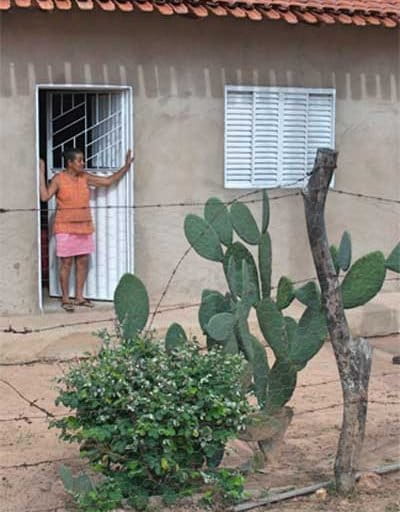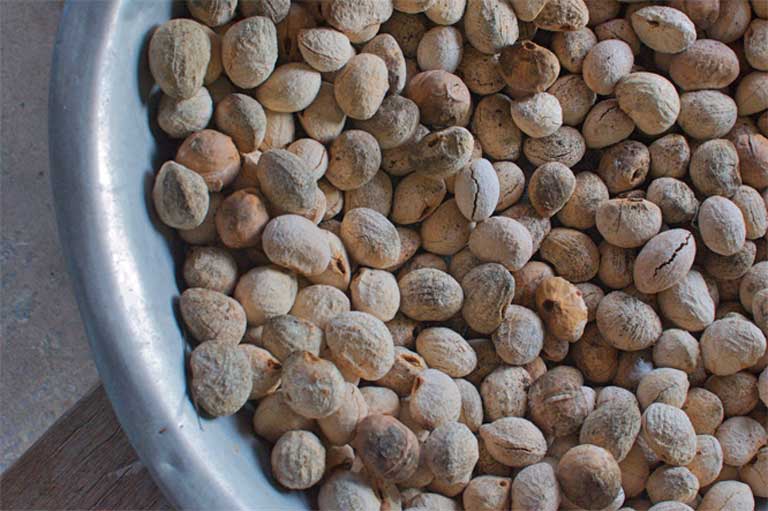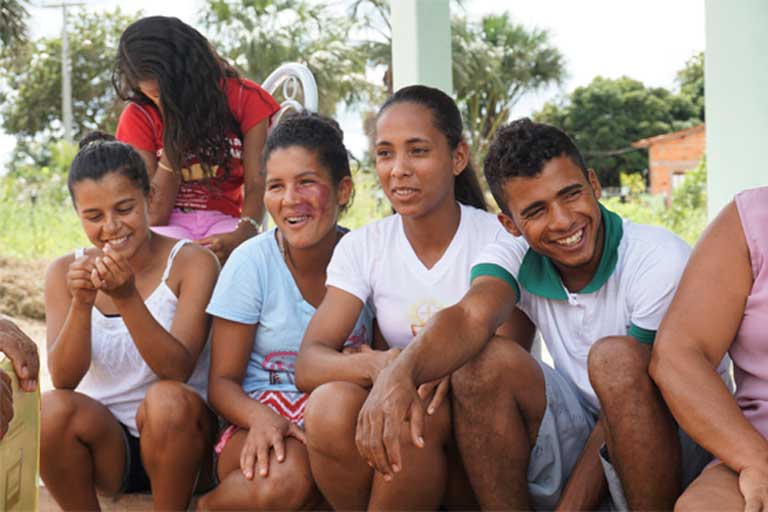- The Cerrado savannah includes many traditional communities. Among them are the geraizeiros who arrived in Western Bahia as much as 200 years ago. For those many years, they occupied small communal villages, and farmed, grazed, and harvested surrounding native lands held by the Brazilian government.
- Typically lacking legal deeds to these lands, the geraizeiros have increasingly come into conflict with agribusiness expansion. Company-run plantations have, according to local people, laid claim to the natural lands, fenced them off, placed guards, then converted native vegetation to soy, corn and cotton monocultures.
- Another conflict: in the Cerrado, a percentage of a land owner’s property must be kept in its natural state, as a Legal Reserve. However, these reserves needn’t be contiguous with croplands. As a result, say local people, agribusiness is laying claim to natural lands that the geraizeiros have long used sustainably for their livelihoods.
- Conflict continues to escalate. The Cerrado states of Maranhão, Tocantins, Piauí and Bahia – known collectively as Matopiba – saw a 56 percent increase in reported land conflicts (400 in total) over the five year period, 2012-2016. In contrast, the national increase over the same period was 21 percent.

This is the fourth of six stories in a series by journalists Alicia Prager and Flávia Milhorance who travelled to the Cerrado in February for Mongabay to assess the impacts of agribusiness on the region’s environment and people.
Barbed wire fencing – going up, and also torn down – are a sign of escalating tensions currently gripping rural areas of Formosa do Rio Preto, Western Bahia, Brazil.
The municipality lies within the Cerrado, the vast Brazilian biome and savannah which is seeing rapid agribusiness expansion. But the area is also home to the geraizeiros, who settled here almost two centuries ago. Like Brazil’s indigenous groups, these traditional communities are recognized by the Brazilian government as having sustainable livelihoods rooted in their territories, and so are worthy of protection. Still, the geraizeiros are on the verge of being displaced by soy, corn, and cotton.
Several other traditional groups live within the Cerrado’s 2 million square kilometers (772,204 square miles), including the ribeirinhos, vazanteiros and veredeiros. But in somewhat the same way in which this vast biome has been politically neglected, even as it is rapidly deforested, its traditional people also remain invisible to most Brazilians, the state and international community.
So it is that they are now raising their voices, and pulling down fences.


Corporate occupation
Geraizeiros are descendants of a mix of cultures, including former slaves and indigenous people, and most settled Western Bahia from the 19th century onward. They fled conflicts and harsh droughts in neighboring regions and built their homes and small farms in already inhabited portions of the Cerrado, rural areas claimed by the government (terras devolutas).
They established their communities in the savannah lowland, the baixões, where rivers plunge down from high tablelands to flow abundantly. Atop the plateaus (chapadas or gerais), they raised cattle in natural grassland pastures, harvested local fruits, and medicinal roots. Land was shared communally by all villages. No fences divided the people, fields or grazing lands then.
The fences and conflict arrived with agribusiness, say locals. In particular, it was erected by Agronegócio Estrondo, a farm owned jointly by 24 companies to produce corn, soybean, and cotton. The plantation is gigantic, currently occupying 305,000 hectares (1,177 square miles), an area almost four times the size of New York City.
Two weeks before our February visit to Formosa do Rio Preto, geraizeiros destroyed the fences and two security cabins erected by Agronegócio Estrondo.

The reason for the action, say local people: the company had blockaded a road that long connected their villages to the city of Formosa do Rio Preto. In addition to the fences, armed men blocked the way, demanded rural people show identification, and only allowed passage during specific hours. At other times, people were forced to travel a longer route to the city.
Armed men also guard Estrondo’s soy crops on the high chapadas. The plateaus are preferred by agribusiness, as they are flat, easy to work with industrial harvesters, and receive plenty of rain. But these are the same lands long used by Enaldo Lopes and other geraizeiros to graze their small livestock herds – a source of more conflict.
In September 2017, Lopes was confronted by the soy guards, and he says, nearly got shot. He was rounding up cattle when three armed men ordered him off his horse. “I pretended I didn’t hear,” Lopes recalls. “Then, they pulled the gun and started shooting at me. If they wanted, they would have killed me, because they were 50 meters away only.”
That wasn’t the first time he was targeted by Estrondo’s armed men. In 2014, after he and his brother protested against another fence being constructed close to their village, both men were handcuffed and driven around in a small truck for three hours, in fear of what would happen next. The two were eventually released unharmed.
Raising cattle is an important part of the geraizeiros’ cultural identity and livelihood. Some of their ancestors were livestock breeders in search of natural pastures. In Western Bahia they found a place to raise their small herds without upsetting nature’s balance. During our February journey, we often were required to stop and wait while the roaming ungulates crossed the sand road in front of us. Honking the horn didn’t impress them much.
Geraizeiros also grow beans, corn, manioc and other crops, mostly in their backyards. Those crops are supplemented by local fruits, fish and game, all taken on a very small scale and for immediate consumption from the surrounding natural lands. The people rely on few items from the city. For long, this system has worked and the natural environment has been maintained.


Escalating Cerrado conflicts
The National Council of People and Traditional Communities (CNPCT, the Portuguese acronym) is a government agency that works to support traditional groups’ rights. It recognizes 29 traditional groups in Brazil, including the geraizeiros, and aims to “recognize and guarantee their territorial, social, environmental, economic and cultural rights, with respect and appreciation for their identity, their forms of organization and their institutions.”
Unfortunately for the geraizeiros, the uncoordinated and largely uncontrolled expansion of industrial agribusiness in the Cerrado has resulted in clashes with traditional communities.
Brazil’s agriculture frontier now extends deep into the Cerrado states of Maranhão, Tocantins, Piauí and Bahia – known collectively as Matopiba – and conflicts there are now numerous. According to data compiled exclusively for this story from the Catholic Church’s Comissão Pastoral da Terra that tracks land conflicts in Brazil, Matopiba has seen a 56 percent increase in reported land conflicts (400 total clashes) over the five year period, 2012-2016. In contrast, the national increase in conflicts over the same period was 21 percent, (with a total of 1,295 conflicts). Statistically, Matopiba’s cases accounted for 30 percent of all conflicts. In Bahia state alone, the number of clashes skyrocketed by 61 percent, with 86 clashes occuring there.
One reason for the violence is lack of protection. Formosa do Rio Preto, with approximately 22,000 residents, is more than 1,000 kilometers (620 miles) away from the Bahia state capital, Salvador, far from the government institutions that might safeguard its rural citizens. The municipality is also now one of Brazil’s biggest soy producers, with 1.4 million tons harvested last year, and projections of 23 percent growth by 2027, according to the Ministry of Agriculture. As a result, agribusiness security forces have become a law unto themselves, say the geraizeiros.
The Estrondo farm was established in Formosa in 1975, and according to locals, it has expanded its growing area onto the natural lands where geraizeiros live, farm and raise cattle. Lopes and others accuse the big grower of land grabbing, or grilagem. Many residents, lacking legal deeds to the surrounding lands where they practice their livelihoods, have seen that land occupied by the farm consortium, and are said to have abandoned their homes.
But the Lopes family won’t go. “I will only leave this place dead,” says Catarina, 59, Ednaldo’s mother who was born there. About a hundred families from eight geraizeiros communities still occupy land along the Rio Preto (Black River). There are no counts of how many families were there previously.
Still, the Cerrado landscape is changing. Native grasses, shrubs and patches of crooked low-growing trees scattered among rocky outcrops, are being replaced by a seemingly endless sea of soy as the Estrondo farm expands to all horizons.
“I got to know this area covered by woods,” says Gisélio Lopes Faria, 70, born in the region. “Around 2005, they brought big chains here to break all [native plants].” The chains were attached to two big tractors, then dragged along the ground to shatter and uproot trees and shrubs. The cultivation of soy, corn, and cotton followed.



Few income sources
Adaltiva Guedes lives in Cacimbinha, one of the last communities along the Rio Preto, more than 130 hundred kilometers (80 miles) from the closest paved road. She used to harvest the golden grass, “capim-dourado” (Syngonanthus nitens) from the veredas, an iconic part of the Cerrado’s landscape – clearings created by wetlands and grasses, framed by tall palm trees.
That golden grass-like species is strong and malleable, good for making earrings, purses, hats and other useful and artistic items. Like many other traditional communities around Brazil, she and her companions used to sell their art to earn cash. But today, Guedes says, “There is little grass left and we can’t pick it up anymore, because they don’t allow us to.” The route to the collecting areas, she explains, are blocked by agribusiness fences, and maybe armed men.
“Estrondo has increasingly expanded farther into the untouched vegetation, and that’s exactly where the geraizeiros are,” explains Abner Mares, from 10envolvimento, an NGO that works with the traditional communities.
He says that the violent threats made by farm guards have been reported to police and to the state Public Ministry’s Office (the MPF, Brazil’s independent Public Prosecutor’s Office operates on both a state and national level). In addition, a lower court in May 2017 found in favor of the geraizeiros in a preliminary decision, safeguarding their land and ordering the removal of Estrondo’s security cabins. However, the farm was not cited until February 2018. In another small victory, an agribusiness fence, planned for the lowlands near traditional villages, was instead placed in the highland. Agronegócio Estrondo did not respond to Mongabay’s request for comment.



“Green land grabbing”
São Desidério, a neighboring municipality, is another important soy growing area, with annual current production of 1,2 million tons, and growth estimated at 34 percent by 2027.
Geraizeiros live there too, in rural areas along the Guará River Valley, only accessible via a long rocky sand road. This isolation has reinforced the identity and independence of the geraizeiros, and it also allowed them to live and work for generations on Brazilian public lands. As a result, few families have legal land titles, true of many rural families in Brazil.
The communities have developed their livelihoods based on the natural cycles of the biome, where they foraged for, and grew their food, and also drew on natural materials and native inspiration to create traditional clothes, arts, crafts, rituals and dances. Living in tune with nature, they developed knowledge of it and learned to live sustainably. It is, say experts, a lifestyle from which the modern world could learn valuable lessons.
“The strategy of conservation of this biome invariably depends on the strengthening of these communities and their ways of life,” says Valney Rigonato, a professor at Federal University of Western Bahia (UFOB), who wrote his Ph.D. thesis about the traditional communities of São Desidério. But, he adds, if these traditional communities are to survive and thrive they must be “guaranteed their access to land and natural resources.”
However, as with other parts of the Cerrado, infrastructure projects and agribusiness monoculture are putting increasing pressure on the seven geraizeiros communities and the 257 families living in the Guará River Valley. A sign at the entrance to the traditional community of Ponte de Mateus states that the surrounding area’s land belongs to a pool of big farms.
“That’s what we call ‘green land grabbing’ (grilagem verde),” Rigonato explains: The native protection law in Brazil – the New Forest Code legislated in 2012 with the help of the powerful bancada ruralista, the agribusiness lobby – requires private property owners to protect a portion of their native vegetation known as Legal Reserves. Depending on biome, a Legal Reserve must account for 20-35 percent of an owner’s property in the Cerrado, and up to 80 percent in the Amazon.
However, the code does not require that these protected lands be contiguous with developed croplands. Therefore, large-scale farms have increasingly laid claim to natural lands – often held without deed by traditional communities – with agribusiness counting them as their reserves.
So the Cerrado’s native vegetation continues growing within these Legal Reserves, at least for the time being. But the traditional people who have always used those lands are pressured to give them up, Rigonato says. According to experts, agribusiness often hires local intermediaries to push the geraizeiros out, either buying their few land titles at low prices, or forcing displacement. In the Guará Valley, communities remain, but many people feel trapped. “Every time there is a different grileiro [land grabber] coming here, I thank God I have my [land] title!” says local resident Joana Maria de Jesus.
The Association of Farmers and Irrigators of Bahia (AIBA), which represents 1,300 associates in the region, did not respond to Mongabay’s request for comment.

Infrastructure projects impact the land
Agribusiness isn’t able to survive without newly built infrastructure. Western Bahia is currently slated for 47 new hydroelectric dams. A thermoelectric power plant and railroad line are already under construction in the Guará Valley. To fuel that plant, Bolt Energias is growing 8,000 hectares (30 square miles) of non-native eucalyptus trees, known for significant water consumption and incompatibility with Brazil’s biodiversity. The company plans to invest R$771 million (US$234 million) in the project.
The trees that replaced native vegetation were planted by geraizeiros families, happy to receive a salary for a few months. Since then, Bolt Energias personnel have disappeared from the site, and the project seems abandoned. But impacts are ongoing.
“Since they planted that much eucalyptus here, the streams [are] diminished,” says Maria Souza dos Santos, who represents Ponte de Mateus community residents.
Bolt Energias says that it has an environmental license to operate the project, but that it has not yet begun to build the power plant. The company didn’t say when it plans to complete construction, nor if it intends to extend its plantation. But when it comes to water, it stressed that other crops, such as corn or coffee, consume more than eucalyptus.


Lacking long-term job opportunities, many in Cerrado traditional communities now rely on government programs for survival. Agribusiness does offer some work to the geraizeiros, but it often utilizes them as a cheap workforce. Genilson Conceição de Jesus is 21 years old and has worked on a soybean farm. He received R$35 (US$10) daily to pull up native plants and prepare the soil for crops. He was happy with that: “It’s good to have an income,” he says.
Another young man was less content. Maycon Gomes de Santana, 23, from the Larga traditional community, used to work for a coffee plantation. He saw a colleague “vomiting blood” due to pesticide poisoning. Others worked 12 hour days without rest to earn R$1,200 (US$364) per month.
“They were exceeding their limits,” says Santana who worked less time for less money and quit after two months. “I prefer farming by myself. We make little, but it’s better than that.”
When one talks of traditional communities, there is an expectation by some people that they might be mostly inhabited by old people. But many young people still reside in the traditional communities of Guará Valley. Six of them joined us for a talk in Ponte de Mateus. Despite the lack of jobs and the conflicts brought by agribusiness, they all want to remain in the village and continue their close relationship with the land.
Fernanda Batista, age 19, is one of the few community members to go to college. In March, she moved to Barreiras, the region’s biggest city, to attend a public university: Still, she asserts, “I want to come back, I want to help improve our life here.”
FEEDBACK: Use this form to send a message to the author of this post. If you want to post a public comment, you can do that at the bottom of the page.














